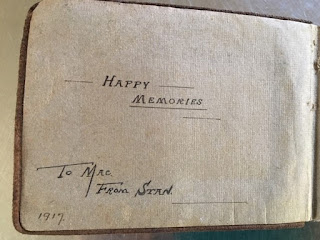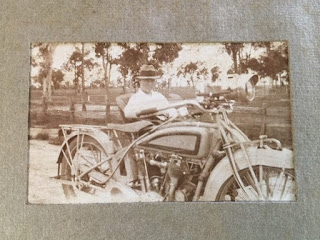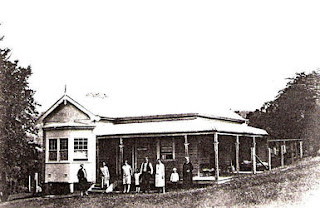#52 Ancestors 2020
Week 33 - Troublemaker.
When my youngest brother was born and my parents decided to
call him Michael, my grandmother was not happy.
“Uncle Mick” (her brother in law) was a drunken no-hoper, and she
thought it was a mistake to give the new baby the same name.
Not believing that naming him Michael would doom him, my
parents went ahead. But when I began my
research into the family, I was curious about the origin of my grandmother’s
hostility to my great uncle Michael and determined to find out more.
Sadly, lots of it was true.
Michael was trouble.
Michael Garrard Gleeson was born in 1892, the second of five
children born to James Patrick and Mary Gleeson (nee Crummy.) He was born In Lismore, NSW where his father
worked for some years on the railways and then in the construction industry. With his partner Jeremiah Finn (his mother-in-law’s
third husband), James formed the company Gleeson & Finn, who were
responsible for building many of the early streets of Lismore, and three of the
reservoirs.
In about 1903, when Michael was 11, the family moved to
Brisbane. It’s not clear what they were
doing for the next few years but by 1916, my great grandfather had a new career
as a publican. He worked at a succession of Brisbane hotels, including the
famous Regatta at Toowong and the Alliance (at Spring Hill). In both of these places Michael worked as a
barman.
In 1914, when WWI broke out, Michael enlisted in the
Australian Army. He served for exactly one month before he was discharged for
health reasons – “bad elbow” was the written excuse.
In 1916, with Australia desperate for new recruits, he tried
again and was accepted. On his admission
sheet for this enlistment, he records one brush with the law – a conviction for
drunkenness*.1 He is described as being
5’6” tall with fair complexion, blue eyes and brown hair. He weighs only 133 lbs (about 52kilograms)
Michael sailed on 24 January 1917 on the troop ship
“Ayrshire”. By April he was in France
with the 15th AIF who fought on the Somme, by July he was in
trouble. His war record states that on 7
July he was charged with “hesitating to obey an order” and “violently resisting
arrest”. In September he was absent
without leave for 24 hours and had his pay docked, then he was hospitalized
with trench fever and sent back to hospital in England.
This seems to have been the end of Michael’s tour of duty –
he remained in England for several months, during which he was constantly
recorded as ‘Absent without Leave” and “Absent from Parade.” In May of 1917 he was shipped home.
Once home, Michael resumed work as a barman at his parents’
hotel. This was perhaps the worst
imaginable place for him to be.
The first newspaper report I can find is dated November
1918. Michael was charged with stealing
a sum of nine pounds and a few shillings, which was the change left on the bar
when another soldier paid for their drinks.
He then refused to give it back.
The case was reported extensively in the Brisbane papers, but in the end
the Judge concluded that all the men were drunk, and as Michael had agreed to
return the money, the case was closed.
In 1919, Michael was charged with stealing a bicycle. The policeman who brought the charge
explained to the magistrate that he would not proceed on the grounds that “the
accused was too drunk at the time of the alleged offence to be capable of knowing
what he did.” In discharging him, the magistrate said, “My advice to you is to
leave the drink alone.”
He didn’t. There is a
string of offences throughout the 1920s.
In 1921 he was charged with stealing some boots while drunk, and in 1922
with breaking into a warehouse with another man and stealing some beer and
stout. In that year, a prohibition order
was taken out against him, forbidding anyone from selling alcohol to him. In 1926, when he was arrested again for
breaking a glass shop door while under the influence, he was remanded on the
basis that he be admitted “to Dunwich”*2
According to Wikipedia, “The Dunwich Benevolent Asylum was a benevolent
asylum for the aged, infirm and
destitute operated by the Queensland Government in Australia. It was located at Dunwich on North
Stradbroke Island in Moreton
Bay and operated from 1865 to
1946."
One of the reasons for his
admission may have been evidence given of an apparent attempt on his own life
in 1921. There is a newspaper report of
him being admitted to hospital after being discovered with a wound to his
throat “recently inflicted” and with blood flowing.
When James and Mary Gleeson bought
the freehold of the Club Hotel in Warwick, Queensland in 1926, it may have been
partly an attempt to remove Michael from Brisbane, but his problems didn’t go
away. There are a few arrests for
drunkenness through the 1930s and in 1938 a more serious attempt on his life. Again, he cut his throat, but this time
inflicted worse damage, with a razor, and was admitted to hospital in a serious
condition. The newspaper reported that
he was not living at home at this time but was found in the vicinity of his
parents’ hotel - I wonder if his parents had given up on him?
Surprisingly, Michael married in
1944, when he was 51. Nothing is known
about his wife, May Austin. Was she a
drinking companion or a positive influence in his life?
If the latter, it was really too
late. Michael died aged 54 in 1947. His death certificate records “chronic
alcoholism” as a major cause of death.
 |
| Michael's grave at Lutwych cemetery in Brisbane |
I felt incredibly sad reading
the trajectory of Michael’s life through the numerous police reports on
“Trove”. While the police, and perhaps
his family, saw him as a troublemaker, he was clearly a very troubled
soul.
There are so many unanswered questions. Was his problem with alcohol already
beginning to manifest itself in 1914, when he was first arrested? Did his time in France during the War make
everything worse, or would it all have happened anyway? Was there something in his childhood or his
family relationships which sowed the seed?
There is no one left to ask.
*1October 1914.
Charged 5 shillings or 6 hours in the lock up.
*2 see clipping









































